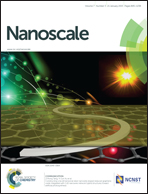Defective TiO2-supported Cu nanoparticles as efficient and stable electrocatalysts for oxygen reduction in alkaline media†
Abstract
Nanocomposites based on TiO2-supported copper nanoparticles were prepared by a hydrothermal method where copper nanoparticles with or without the passivation of 1-decyne were chemically grown onto TiO2 nanocolloid surfaces (and hence denoted as CuHC10/TiO2 and Cu/TiO2, respectively). Transmission electron microscopy measurements showed that the size of the hybrid nanoparticles was 5–15 nm in diameter with clearly defined lattice fringes for anatase TiO2(101) and Cu(111). The formation of anatase TiO2 nanoparticles was also observed by X-ray diffraction measurements. FTIR measurements confirmed successful attachment of alkyne ligands onto the surface of the copper nanoparticles via Cu−C![[triple bond, length as m-dash]](https://www.rsc.org/images/entities/char_e002.gif) interfacial bonds in CuHC10/TiO2. XPS measurements suggested the formation of CuO in both samples with a higher concentration in Cu/TiO2, and interestingly Ti3+ species were found in CuHC10/TiO2 but were absent in Cu/TiO2 or TiO2 nanoparticles. Electrochemical studies demonstrated that both Cu/TiO2 and CuHC10/TiO2 exhibited a markedly improved electrocatalytic performance in the oxygen reduction reaction, as compared to TiO2 nanocolloids alone, in the context of the onset potential, the number of electrons transferred and the kinetic current density. Importantly, among the series, CuHC10/TiO2 exhibited the best ORR activity with a high current density, an almost four-electron reduction pathway and long-term stability after 4000 cycles at high potentials, which may be ascribed to the defective TiO2 structures in combination with surface ligand engineering.
interfacial bonds in CuHC10/TiO2. XPS measurements suggested the formation of CuO in both samples with a higher concentration in Cu/TiO2, and interestingly Ti3+ species were found in CuHC10/TiO2 but were absent in Cu/TiO2 or TiO2 nanoparticles. Electrochemical studies demonstrated that both Cu/TiO2 and CuHC10/TiO2 exhibited a markedly improved electrocatalytic performance in the oxygen reduction reaction, as compared to TiO2 nanocolloids alone, in the context of the onset potential, the number of electrons transferred and the kinetic current density. Importantly, among the series, CuHC10/TiO2 exhibited the best ORR activity with a high current density, an almost four-electron reduction pathway and long-term stability after 4000 cycles at high potentials, which may be ascribed to the defective TiO2 structures in combination with surface ligand engineering.


 Please wait while we load your content...
Please wait while we load your content...